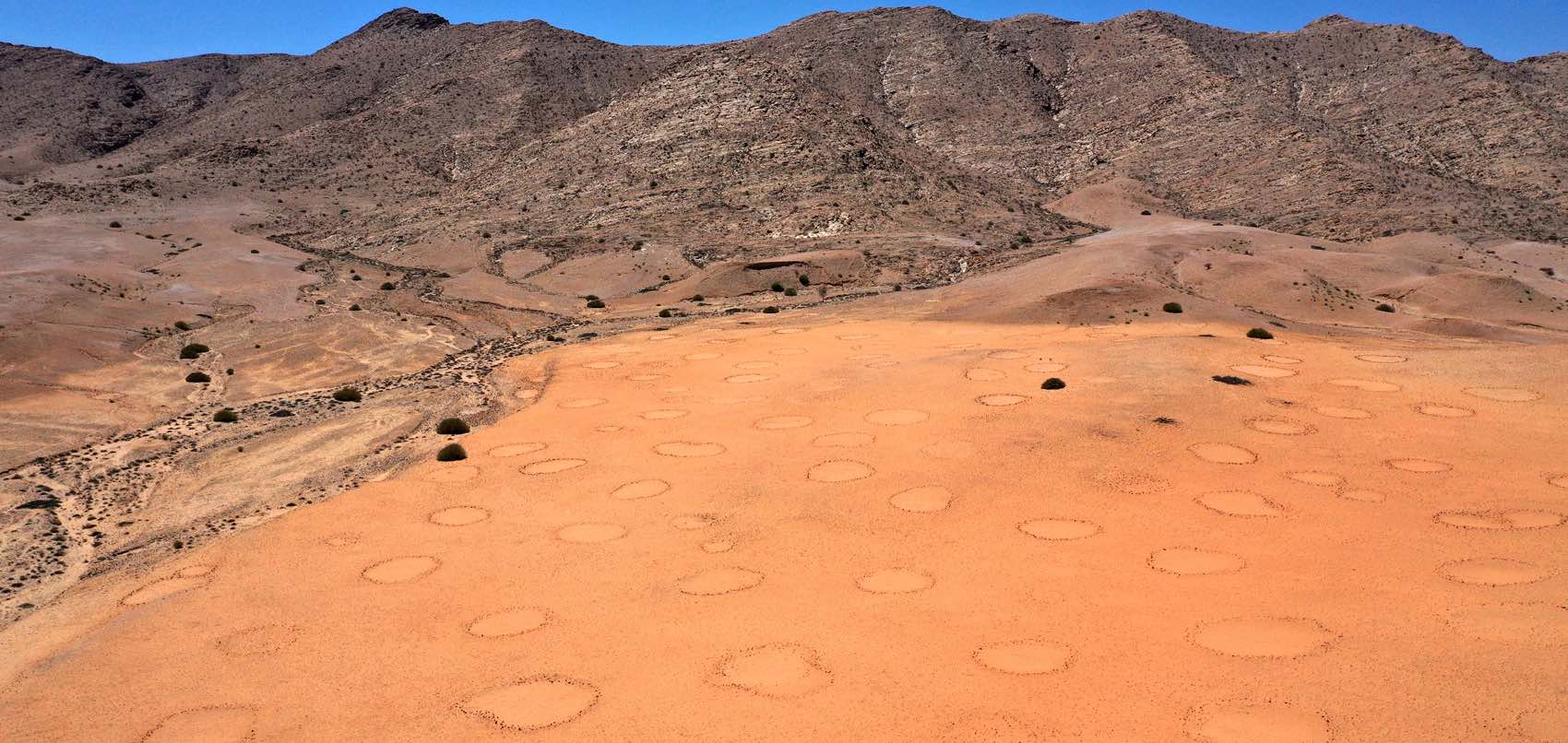

The Plot Thickens - Euphorbia bushes do not cause fairy circles
15th June 2021
I would like to thank Dr. Stephan Getzin for checking the text and providing photographs.
Earlier this year, new scientific research suggested that common desert shrubs in the Euphorbia genus were creating fairy circles after they died. This research revived one of the first scientific theories from 1979 about how fairy circles are formed in the arid areas of Namibia. Another journal article published since then refutes this theory after researchers investigated the sites of dead Euphorbia bushes that were marked in the 1970s, along with other lines of evidence.
Science is a continual state of exploration, which is one of its most attractive features for those with inquisitive minds. It can also be quite daunting, however, as the end results of what may be months of hard work are put on display for other scientists to pick apart and either counter or support your work. Ultimately, this is one of the great strengths of the scientific process – our colleagues prevent us from keeping favourite theories alive that are ultimately wrong. Together, we slowly approach the truth.
Fairy circles – almost perfectly round, bare patches of soil ringed by dense stands of grass that are surprisingly regularly spaced across the landscape – have proven as enigmatic as their name suggests, and the hunt for what causes them is a great example of science at work. Different research teams all brought their own expertise and perspectives to bear on this mystery, using a variety of different methods to find evidence indicating what causes fairy circles. Each piece of new evidence either strengthens or weakens current theories, or suggests totally new ones for consideration. The final goal, as with all scientific endeavour, is to find one coherent theory that accounts for all of the evidence.

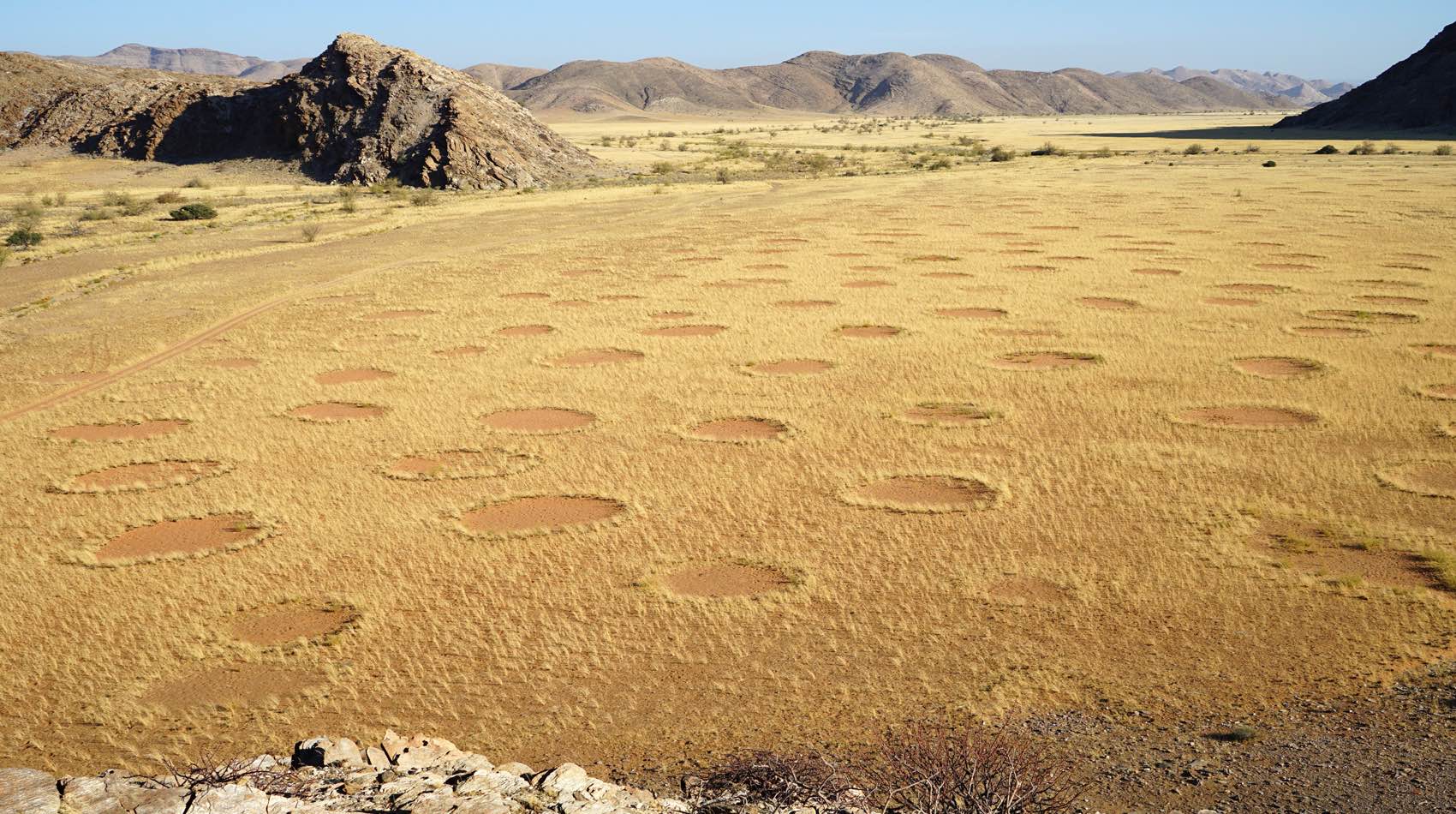
The Euphorbia theory that was first postulated by G.K. Theron in 1979 suggests that dying Euphorbia bushes change the nature of the soil underneath them such that grass can no longer germinate or grow in the circular patch of soil that they leave behind. Following some experiments showing that the soil under Euphorbias does not inhibit plant growth, this theory was put on ice, while other theories were put forward relating to termites, gerbils, ants, microbes, gas and competition among plants.
Prof. Marion Meyer and his team reconsidered the Euphorbia theory in their recent paper. Their laboratory soil tests revealed that water infiltrated the soil taken from under Euphorbia bushes very quickly and that grass plants were less likely to germinate in this soil when minimal water was provided (mimicking desert conditions). They supported this evidence by mapping the distribution of Euphorbia bushes, bushes and fairy circles together, and fairy circles only using satellite imagery. Finally, they correctly predicted that fairy circles would occur further east than they had been previously recorded. They concluded that the original Euphorbia bush theory is a strong candidate for what caused fairy circles.
Such a conclusion was rather surprising for scientists who had long since dismissed any link between Euphorbias and fairy circles. It therefore didn't take long for another team of researchers to examine the evidence presented by Meyer and his team to find out whether or not this theory really does hold water. Dr. Stephan Getzin from the University of Goettingen brought together a team (including Ailly Nambwandja of the Gobabeb-Namib Research Institute) to critically evaluate the lines of evidence presented by Prof. Meyer and his students.
They started by going back to the very first experiment to evaluate this theory – set up by G.K. Theron himself in 1979. In a farsighted experiment, Theron marked several dying Euphorbia bushes with durable metal stakes, along with some fairy circles and others set between fairy circles where no Euphorbias were growing. Because fairy circles persist in the environment for many decades and Euphorbias take a long time to decompose, it is difficult to observe what is happening and therefore test this theory directly. Theron's metal stakes provided a unique opportunity to study the effects of Euphorbia deaths over a suitably long time period of 40 years.
Dr. Getzin and his team managed to locate four stakes that were pinned at dying Euphorbia sites on the ground, which allowed them to find satellite images of these locations from 2009 and update these images with higher resolution drone footage taken in March 2020. Their resulting photographic time series shows decomposing Euphorbia bushes amongst fairy circles that disappear almost entirely over time – the locations of dead bushes eventually look exactly like desert grassland, and nothing at all like fairy circles. Examining the dead Euphorbias on the ground also revealed grasses growing directly under the bushes, which again cast doubt on the theory that the soil under Euphorbias makes it difficult for grass to germinate and grow.
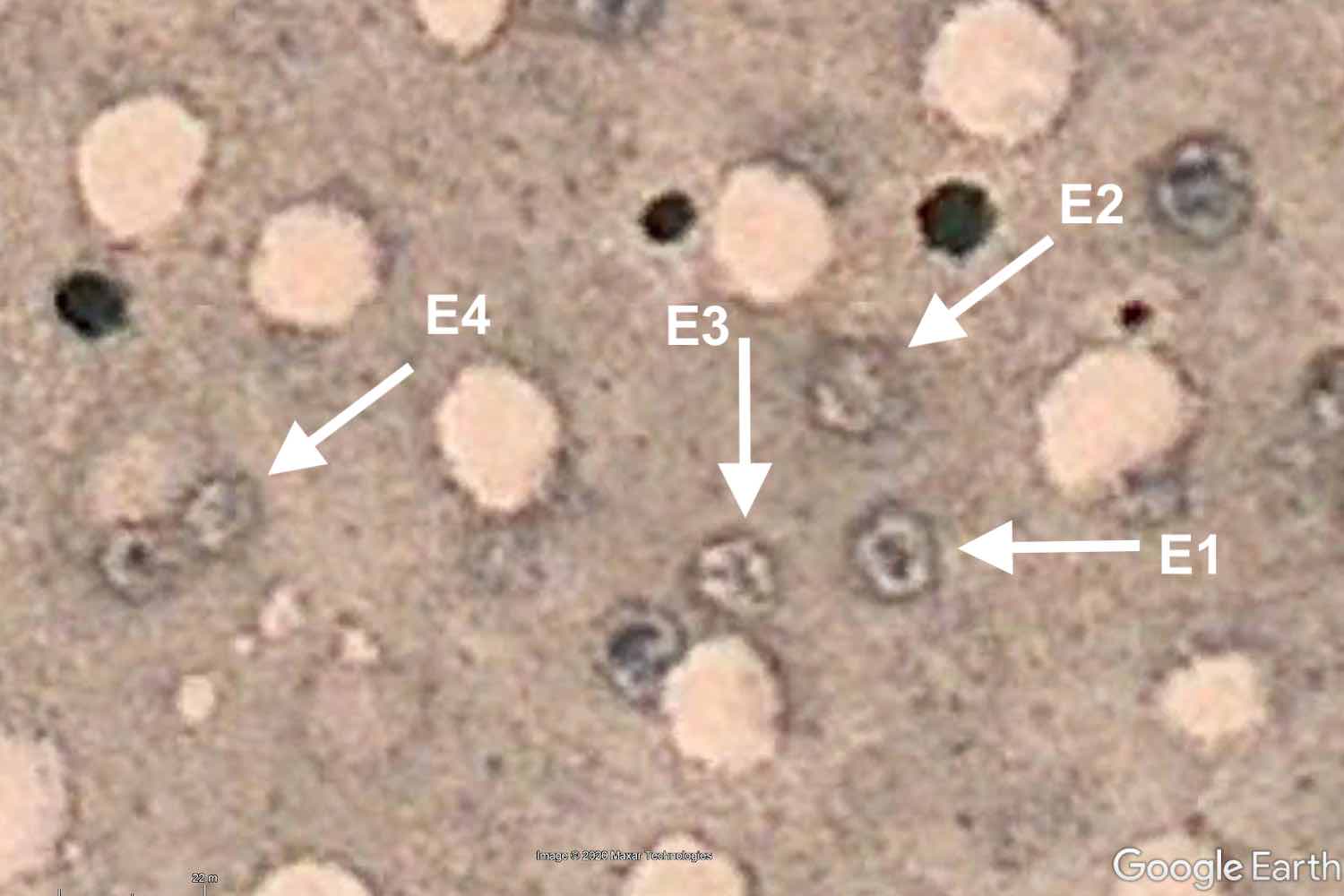
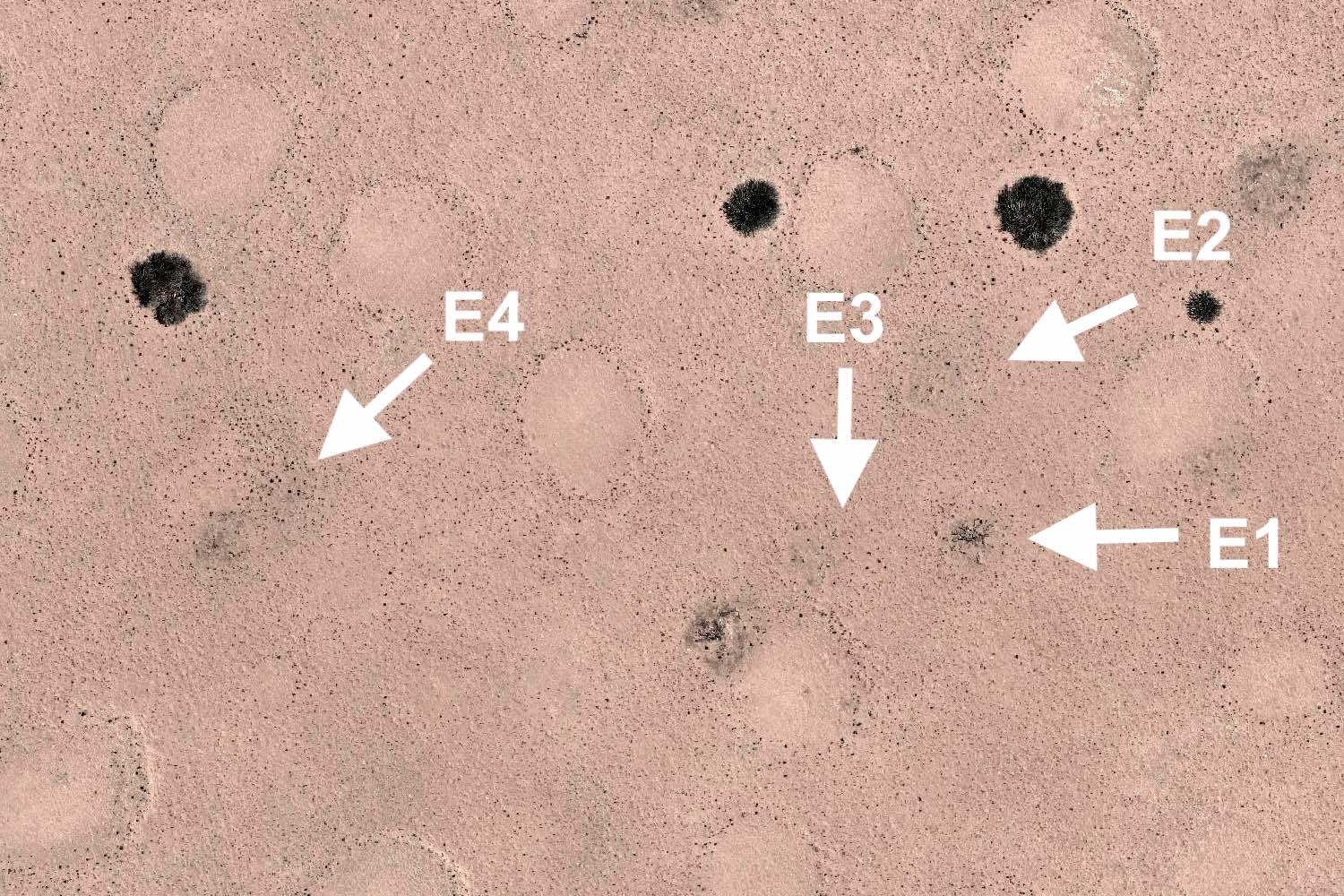
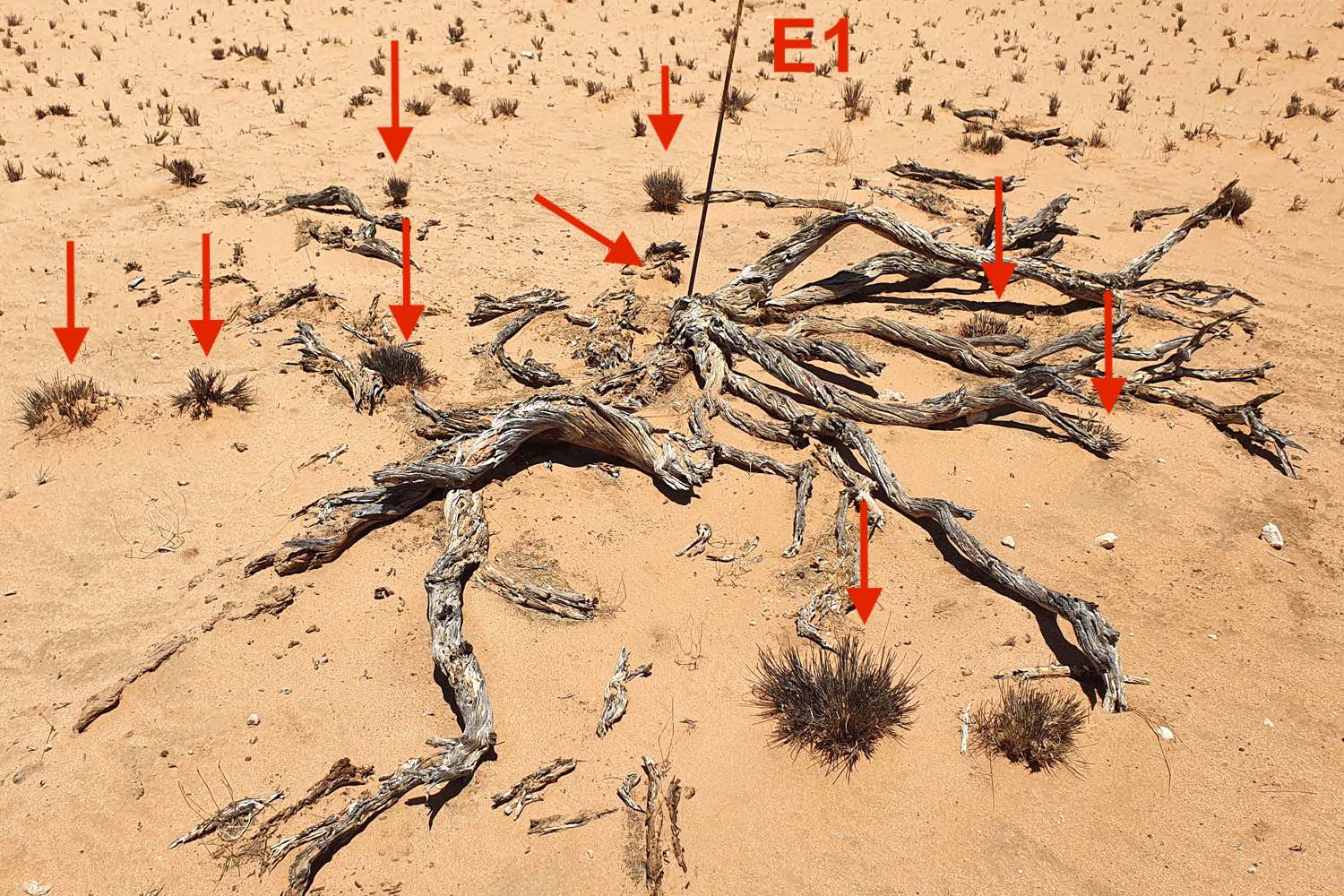
While this evidence on its own is quite strong, the team went further by gathering several other important bits of data. First, they determined whether the sizes of dying Euphorbias matched the sizes of fairy circles in the immediate vicinity. In one of their study sites, they measured the largest fairy circles and the largest dying bushes, while in the other they measured the smallest fairy circles and the smallest dying bushes. In the former study site, none of the dying bushes were large enough, while in the latter study site, none of the dying bushes were small enough to generate the fairy circles found in each area respectively.

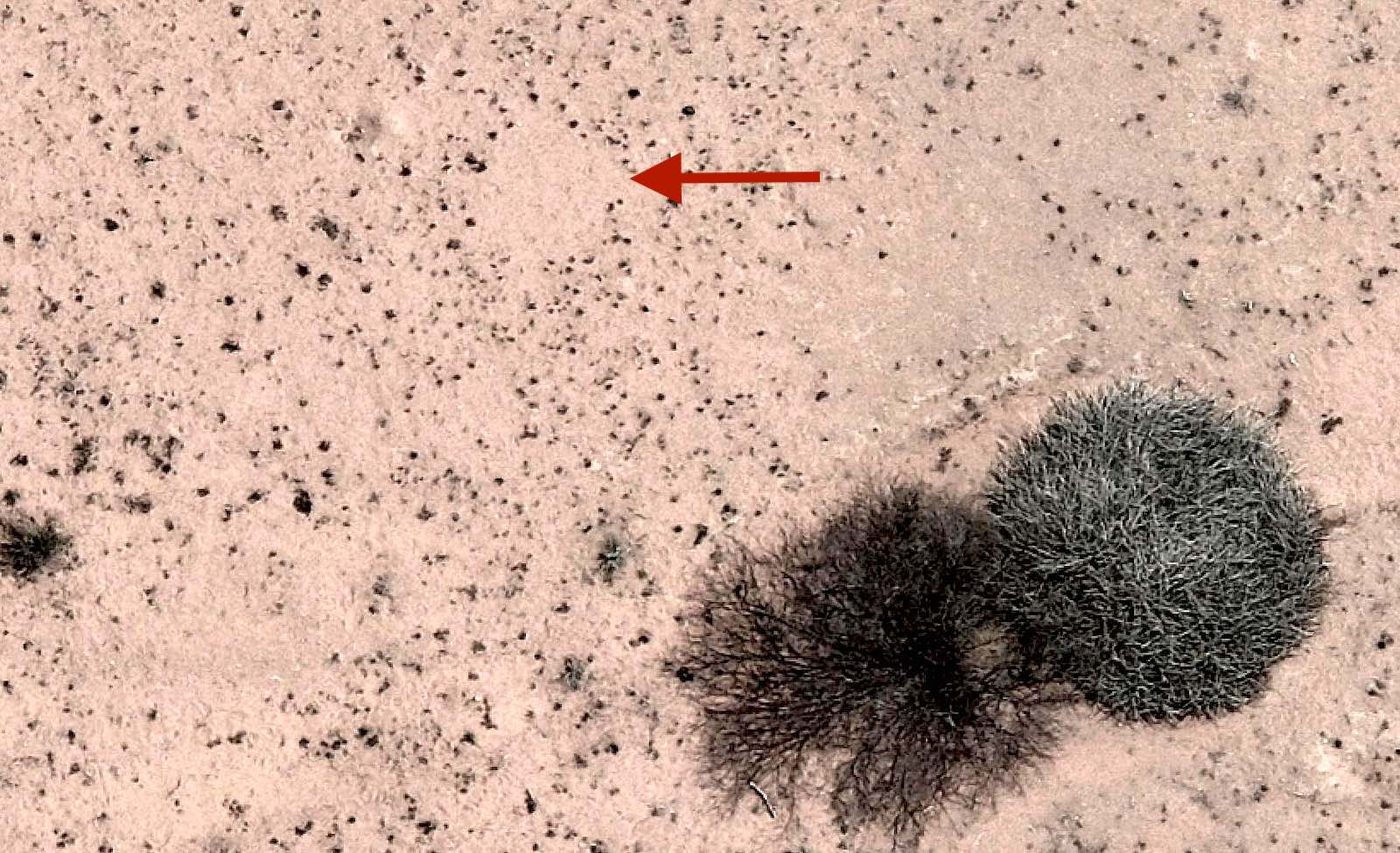
The team further re-examined the evidence based on spatial patterns of Euphorbias and fairy circles. One of the most enigmatic features of fairy circles is that they have a very regular distribution across the landscape – i.e. they do not cluster in particular places. In sandy, flat areas where they occur most frequently, each circle has only six direct neighbours, which are all roughly the same distance from it. Theories about what causes fairy circles must therefore account for this highly ordered pattern over large areas.
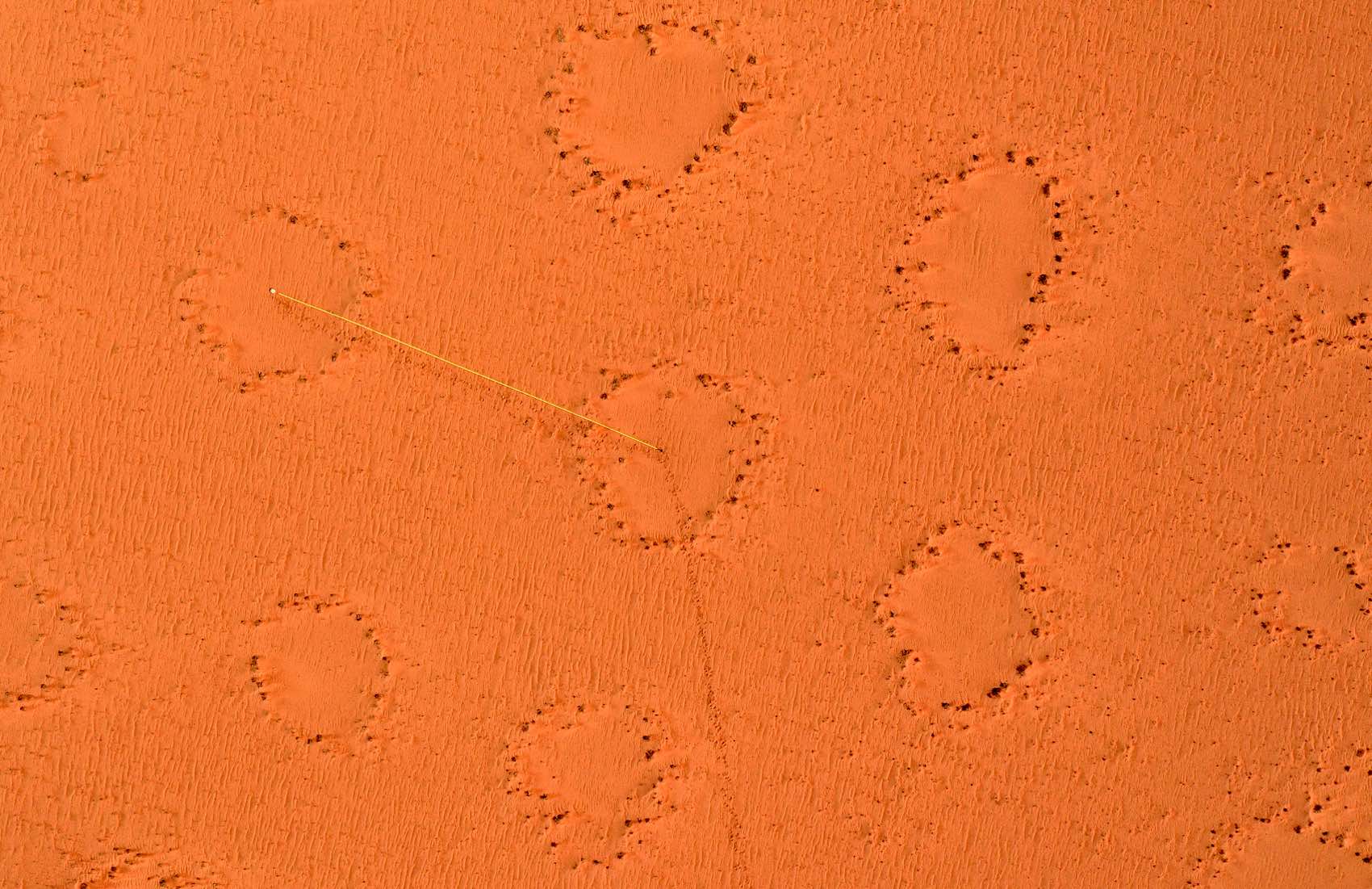
Using a drone, Getzin's team mapped the distribution of fairy circles and Euphorbia bushes to compare their distributions. Meyer's team used lower-resolution satellite imagery and clumped location data of Euphorbias together with fairy circles. Getzin and colleagues postulated that if dying Euphorbias become fairy circles, then their spatial distribution (on their own) should have a similarly regular pattern to fairy circle distribution, especially if they are in the same area (thus controlling for other environmental factors). By separating the Euphorbia spatial data from the fairy circle spatial data, they showed that Euphorbias are predominantly clustered or randomly distributed (depending on the site), while fairy circles in these same areas are regularly distributed. They further point out that there is no biological reason why Euphorbias should be regularly distributed like fairy circles, as young Euphorbia plants are more likely to survive in sheltered areas near other plants than out in the open.
The argument that soil infiltration rates in fairy circles are different to infiltration rates in the surrounding soil also came under scrutiny. While Meyer and his team took soil samples to test in the lab, Getzin and team measured infiltration rates in the field. The latter found that infiltration rates in fairy circles were faster, slower and exactly the same than in the surrounding soil at three different study sites (each site gave a different result). Water infiltration rates therefore do not explain why grass does not grow inside fairy circles.
The final nail in the Euphorbia theory's coffin is the observation that there are large stretches of Namib Desert where fairy circles occur, but Euphorbia plants are entirely absent. Meyer and colleagues speculated that these fairy circles were artefacts of a time when Euphorbias were plentiful in those areas, but no longer occur there due to climate change. In their rebuttal, Getzin and colleagues review evidence of fairy circles appearing in these areas in the absence of Euphorbia bushes (as seen in a time series of satellite images from 2004-2013). They also note that Euphorbias prefer growing in rocky areas, whereas many large areas covered by fairy circles are sandy and therefore unsuitable for Euphorbias. The current absence of Euphorbias in large sandy parts of the desert where fairy circles are prevalent therefore has nothing to do with climate change.
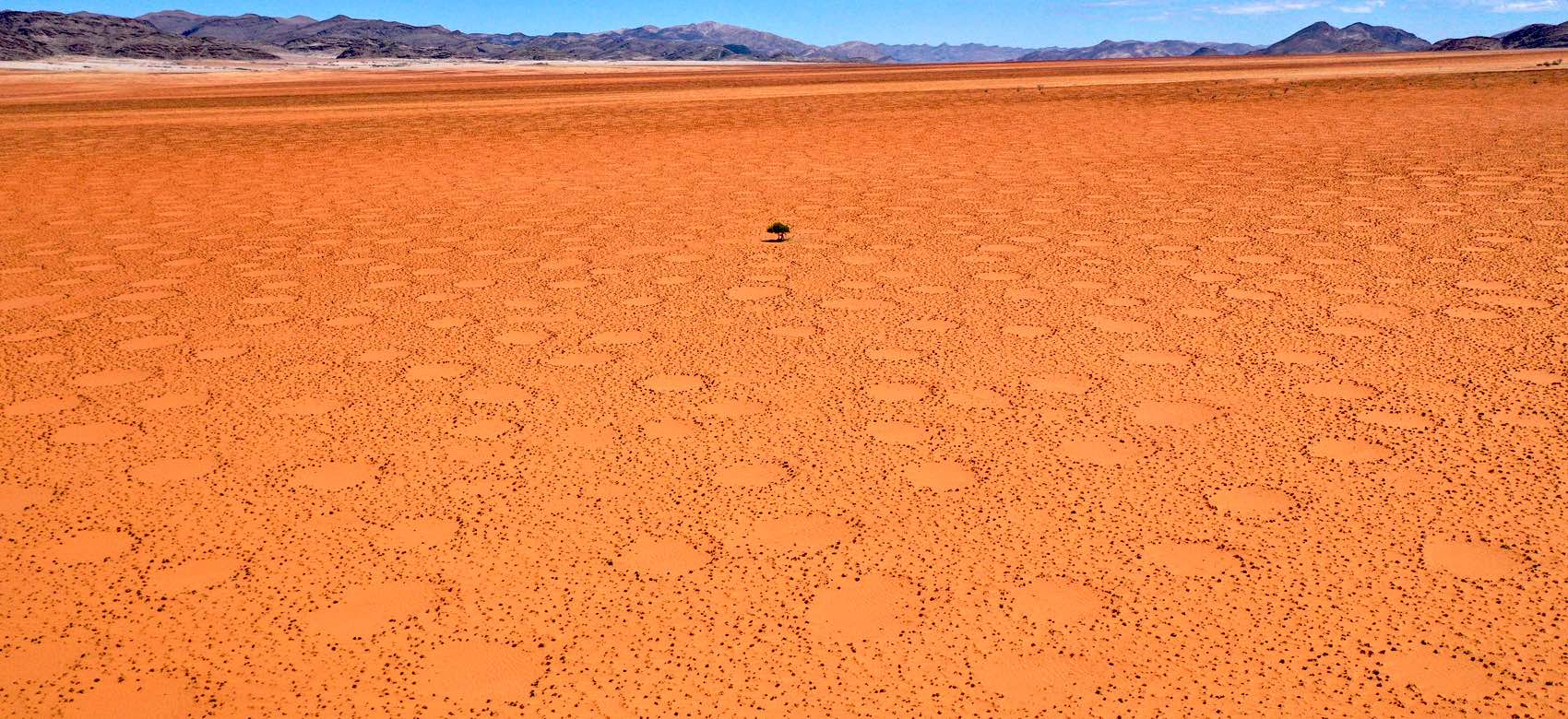
The Euphorbia theory is not alone in being criticised and picked apart, however. One of the most popular theories is that termites cause fairy circles by eating the grass in the centre, yet Dr. Getzin, Prof. Meyer and other scientists (including a southern African termite expert) view this theory with scepticism. First, the biology of termites and their resulting spatial distribution in the environment does not match the highly regular spacing of fairy circles over large areas. Second, although fairy circles only occur in a very narrow band of Namibia that receives 70-120 mm of rain per year, the termite species that supposedly cause these circles are found in much wetter areas further east, where fairy circles are absent. Third, similar termite numbers have been found within and outside fairy circles, indicating that termites do not need to create circles to survive in this environment. Finally, not all fairy circles have evidence of sand termite activity in or around them.
Dr. Getzin favours what is known as the vegetation self-organisation theory. In simplified terms, self-organisation is the result of plants competing strongly for scarce water resources. As they do, gaps in vegetation form where grasses are outcompeted by others and therefore die. The appearance of fairy circles (in the absence of Euphorbias) has been linked to multi-year droughts, suggesting that they are most likely to form when grasses are highly water stressed and competition among them becomes especially fierce. Similarly, the disappearance of fairy circles seems more likely when the desert receives several consecutive years of good rainfall. Fairy circles do not occur at all in areas where the average rainfall is 150 mm or more, as competition for water is less intense in wetter areas.
Although the vegetation self-organisation theory does account for the regular spacing of fairy circles and their occurrence only under particular climatic conditions, much is still to be learned about these enigmatic circles. For example, why do the seeds of grass plants on the edge of fairy circles not re-colonise these bare circles for several decades? Even though some fairy circles disappear (i.e. grasses re-colonise them) after several years of good rainfall, they don't all disappear at once – why do some vanish and others stay the same?
Figuring out what causes natural phenomena that occur over long time periods and are not easily replicated in laboratory conditions is a major scientific challenge. The fairy circle mystery is one such challenge that has been examined from almost every conceivable angle. Perhaps the answer lies solely in vegetation self-organisation, or perhaps several of the possible causes work together to create and maintain these bare circles? We do not yet have all the answers, but the tortuous process of scientific theorising, data collection and peer-review will get us there in the end.
Key reference: Getzin, S., Nambwandja, A., Holch, S. and Wiegand, K. (2021). Revisiting Theron's hypothesis on the origin of fairy circles after four decades: Euphorbias are not the cause. BMC Ecology 21:102. https://doi.org/10.1186/s12862-021-01834-5
For articles on similar topics, please click one of the following options:
If you enjoyed this page, then you might also like:




The Namibian Chamber of Environment (NCE) is an umbrella Association that provides a forum and mouthpiece for the broader environment sector, that can lobby with government and other parties, that can raise funds for its members and that can represent the sector.
www.n-c-e.orgThe Namibian Chamber of Environment (NCE) is an umbrella Association that provides a forum and mouthpiece for the broader environment sector, that can lobby with government and other parties, that can raise funds for its members and that can represent the sector.
www.n-c-e.org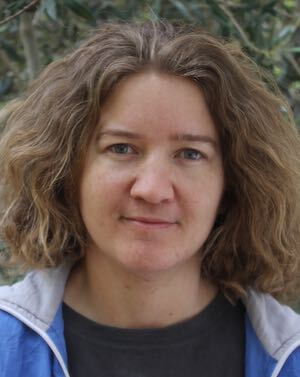
Gail C. Thomson is a carnivore conservationist who has worked in South Africa, Namibia and Botswana on human-carnivore conflict, community conservation and wildlife monitoring. She is interested in promoting clear public communication of science and conservation efforts in southern Africa.
Gail C. Thomson is a carnivore conservationist who has worked in South Africa, Namibia and Botswana on human-carnivore conflict, community conservation and wildlife monitoring. She is interested in promoting clear public communication of science and conservation efforts in southern Africa.
We use cookies to monitor site usage and to help improve it. See our Privacy Policy for details. By continuing to use the site, you acknowledge acceptance of our policy.